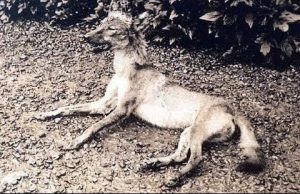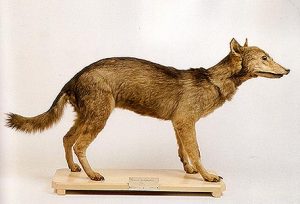Updated on: 28/03/2022
The Japanese Wolf is an extinct subspecies of the gray wolf that was last seen at the prime of the 20th century. Owing to its small size the Also called the Honshū Wolf, the classification of the animal as a subspecies is disputed. Many biologists believe that because of its small size and other its physical differences, it should be considered as a separate species, yet others think that it may not have even been a true wolf at all.
| Kingdom: | Animalia |
| Phylum: | Chordata |
| Class: | Mammalia |
| Order: | Carnivora |
| Family: | Canidae |
| Genus: | Canis |
| Species: | C. lupus |
| Subspecies: | †C. l. hodophilax |
| Other Names: | Hondo Wolf, Yamainu, Mountain Dog |
| Year of Extinction: | 1905 |
| Size: | About 35 inches (90 cm) in length |
| Height: | Around 12 inches (30 cm) inches at the shoulder |
| Weight: | Light (exact not known) |
| Average Lifespan: | Up to 13 years in the wild, and 15 in captivity |
| Location/Distribution & Habitat: | It was found only in Japan in the islands of Honshu, Shikoku, and Kyushu, primarily in the remote mountainous regions |
| Climate/Environment: | Warm to moderate |
| Diet: | Carnivorous |
| Birth Type (Reproduction): | Viviparous |
| Locomotion: | Quadrupedal |

In 1732, when contagious rabies began to spread in the country, the population of the Japanese wolf began to diminish. The first report of the disease, which is said to have been introduced by humans, was reported in the islands of Kyūshū and Shikoku. Such an incident in parts of the country began to affect the number of these wolves largely, and this continued for almost a century.
Some researchers debate that the disease was spread purposely in order to kill the wolves, whose every existence in the locales had already been a matter of concern for the local people. However, others think that the domestic dogs might have transported the disease. But, whichever way, the humans, with their rabies-induced aggression, began to persecute the wolves in general and began to kill them in large numbers, eventually leading to their extinction.
Deforestation also played a significant role in the extinction of these creatures, since such an action forced the animals in coming into direct conflict with the human population, which in turn provoked the farmers to target the packs and kill them gradually. Other sources also claim that these canids were exterminated as a national policy.

As the world’s smallest known wolf, this animal grew up to approximately 35 inches in length from nose to tail with a height of around a foot. They had a small head with an elongated muzzle, with the jaws lined with sharp teeth, with a close resemblance to dogs, jackals, and coyotes. The entire body was covered with short a coat of wiry hair, while the thin dog-like tail had long hair and had a rounded end. They had thin but elongated eyes, small, erect ears, and short legs.
The only food of the Honshu wolf was meat, and they are known to prey upon animals larger than them, including wild boar and deer. Since they would also hunt down smaller pests and rodents like rats that usually damage crops, they were praised by the farmers.